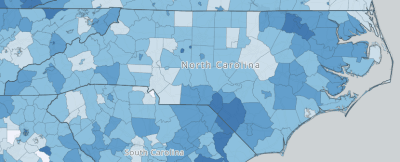We’ve got some STEMpathy if you’re kind of over stories about science, technology, engineering, and math (STEM) jobs, and the education and training required to get them. But there’s a good reason for all (or at least most) of those stories: employment in STEM occupations tends to be higher-wage and higher-growth than other occupations. With startlingly low economic mobility for young people in the South, STEM jobs could provide new pathways into stable careers.
In many Southern metros, STEM employment makes up a significant portion of the workforce. According to Bloomberg Business, in Austin, Huntsville, Raleigh, Durham, the figure is at least 10 percent:


These jobs typically pay better than many occupations, and they are more likely to have the characteristics that allow for economic security and wealth building, like paid sick and family leave, health insurance, and retirement accounts. The gap between median pay in STEM occupations and non-STEM occupations is substantial in many Southern metros:


The prevalence of these jobs in certain areas is not based just on luck; they are areas that have seen sustained investment in innovation and education over time. From Bloomberg Business descriptions of Huntsville and Durham:
Like many high-tech locales, Huntsville owes its 21st century economy to an initial burst of funding for government research. It was a town of 16,000 residents working in cotton mills and on watercress farms when, in 1950, the U.S. Army relocated a team of rocket scientists to Redstone Arsenal, a local installation that produced chemical munitions during World War II. In the decades that followed, NASA designed, assembled, and tested the rockets that put the first men on the moon. Boeing, Lockheed Martin, and dozens of lesser-known aerospace and defense companies have swarmed to Huntsville.
….
Durham, N.C., has a STEM labor force that’s 13.9 percent of all workers. Its biotech economy started with a sprawling research park that began to grow around the same time that Huntsville’s high-tech transformation was getting started.
The Bloomberg author notes that these jobs pay good salaries and those salaries support other draws — like good public schools, restaurants, and arts and entertainment that make the communities appealing to potential employers and potential workers.
Job growth doesn’t happen automatically, and it’s happening less and less through traditional industrial recruitment. STEM jobs are growing in the places where there’s been investment in the services, amenities, and institutions that support those sectors, and particularly in places with a highly educated workforce or the ability to attract one.
These occupations are typically high-skill and require targeted training and education, but the majority are going to populations that are the most likely to connect with high-wage work anyway: white men. Women and people of color are underrepresented in STEM fields. Women make up less than a third of all STEM employment in every Southern state:


Southern cities that are seeking to take advantage of STEM job growth must make sure that the pathways into those jobs are strong and equitable. We have to consider what barriers, both real and perceived, are preventing women and people of color from pursuing those careers in greater numbers.
As the Institute for Women’s Policy and Research found, women are significantly less likely than men to get degrees in STEM fields, and the proportion of women receiving associate’s degrees in STEM fields decreased between 2001 and 2009:


Though these data show a significant gender gap, community colleges are an important part of the pathway to STEM careers for both women and men, as detailed in an article this week by Lane Florsheim in Marie Claire magazine. More than half of people who receive bachelor’s degrees or higher in a STEM field completed some of their coursework at a community college, including 55 percent of women (63 percent of women with young children) and 44 percent of men.
Florsheim cites research that suggests community colleges are often more accessible and inviting to women interested in these fields:
… a recent study by two Iowa State University researchers found that women at community colleges reported a friendlier atmosphere in STEM-related classes than at four-year colleges. “It is just such a global community,” one student said of her community college experience. The researchers found that similarity in backgrounds and lifestyles made women feel more comfortable stepping into leadership roles in activities and assignments. Strong advising and support from faculty also marked a major difference. Since so many students transfer out, they often work closely with guidance counselors to develop transfer plans. “The two-year plan keeps me focused, and saved me with financial aid,” another woman said.
That welcoming atmosphere, where women and people of color are encouraged and expected to thrive instead of being seen as unusual, must be sustained at community colleges and created at other educational institutions. It hasn’t always been so unusual: computer programming was once thought of as women’s work, but it became overwhelmingly male starting in the mid-1980s as stereotypes about gender and computer science shifted:


Stereotyped messages about who “belongs” in a field matter to young people who are trying to envision themselves in careers.
Holding that vision is difficult to do while women in corporate leadership, especially tech corporate leadership, are few and far between. Only 5 percent of Fortune 500 companies have female CEOs (women make up 15 percent of C-level executives and 17 percent of board members, even though research shows that boards with women tend to outperform boards without women). A TechCrunch analysis of 84 “unicorn” companies, or U.S. software or internet-oriented companies that are backed by venture capital and valued at more than $1 billion, found that only two CEOs are women, 30 percent have no women in senior leadership, and approximately 70 percent do not have women on their boards. And a Fortune analysis of 191 major U.S. venture capital firms — the crucial backers of tech innovation — found that only 5.6 percent of decision-makers and 10 percent of all investment professionals were women.
The power of these stereotypes is seen in a study of academia that found fields that prioritize brilliance and raw talent tend to have lots of white men in them, while fields that emphasize the importance of hard work tend to have larger percentages of women and people of color. Unconscious bias influences who we think of as brilliant and talented — if you don’t look like the typical applicant, then the employer may not be as able to see your unique talent. Women make up 20 percent or less of PhDs in physics, engineering, and computer science; it’s understandable that young women may not see STEM fields as welcoming for either education or employment.
For the Southern economy to thrive, our workforce needs the skills to compete in the global economy and emerging fields — and we need those skills to be accessible to a broad range of workers, including women and people of color. STEM skills will often be highly technical and specialized, requiring both postsecondary training and job-based experience. Developing equitable education and hiring systems can help us shift patterns of economic mobility and ensure that more Southerners can connect to living-wage careers.
This article was originally published in the State of the South blog on October 2, 2015.


